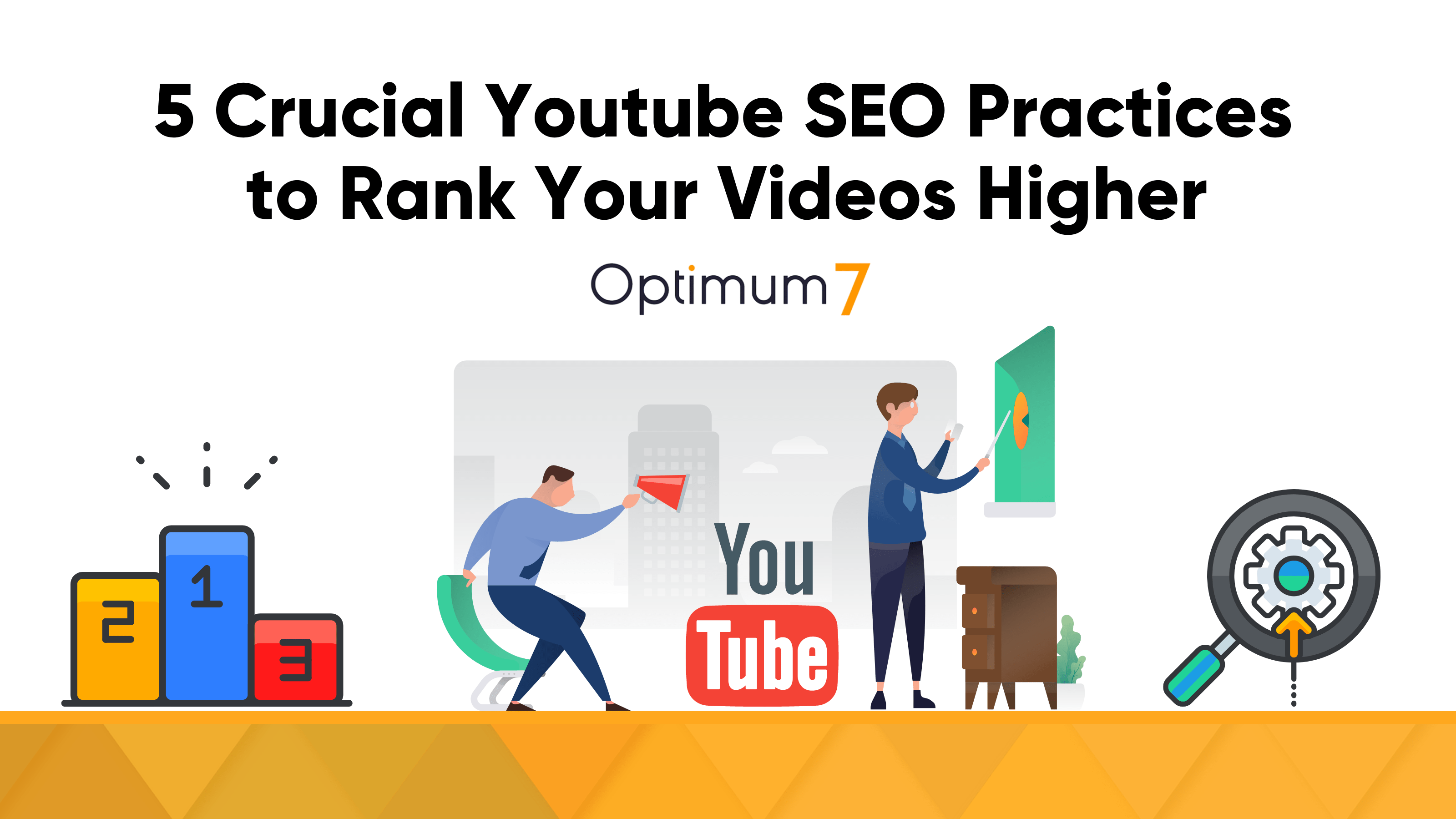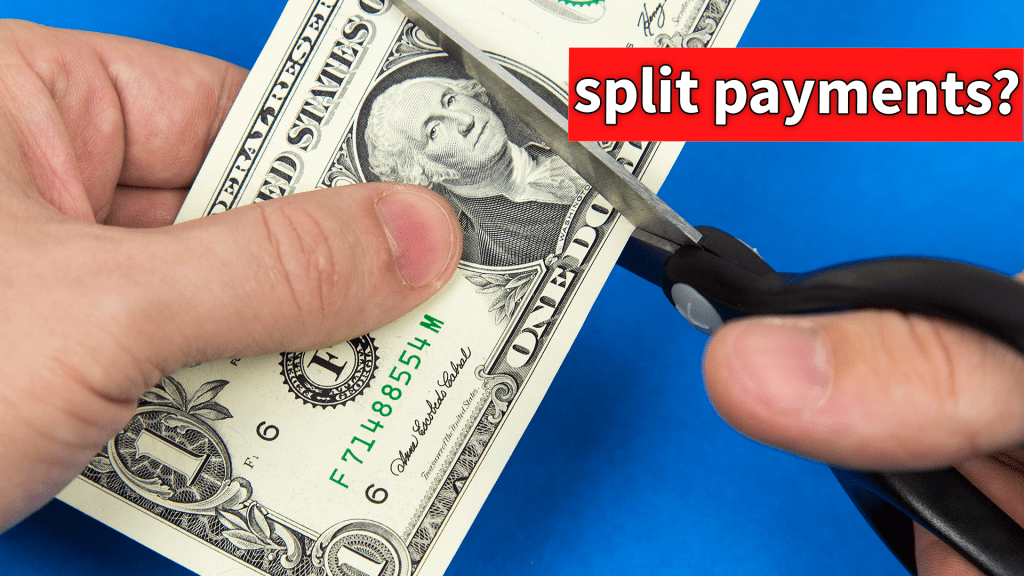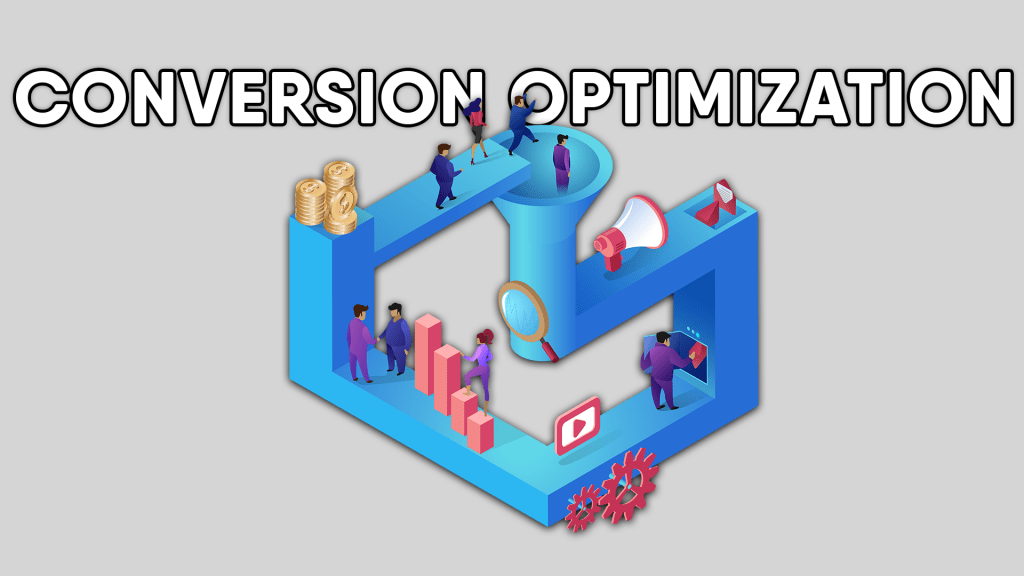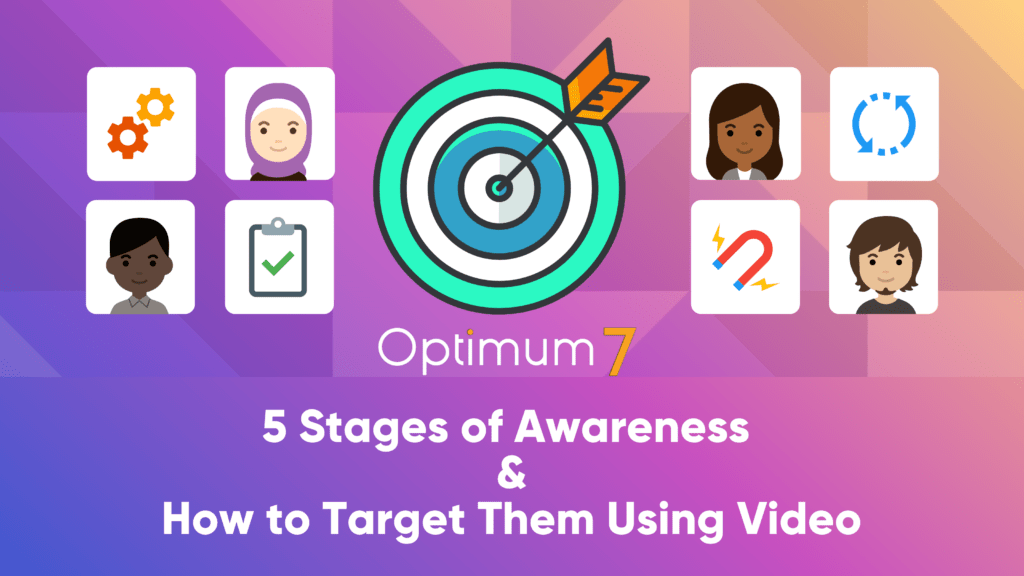In this article, we will be discussing the untapped potential of SEO for YouTube and Video SEO. With the increasing competition to rank on the first page of Google, many businesses overlook the fact that ranking for certain keywords can be made easier by using video.
Google now triggers video results for certain search terms. As YouTube is owned by Google, optimizing video content (such as subtitles, tags, optimized titles, descriptions, hashtags, and time frames) can lead to ranking on the first page of Google search results.
The business side of why Google loves Youtube SEO will also be explained. This post will also provide helpful tips for business owners who are new to video marketing and will show the immense potential of video SEO.
Video SEO: A New Way to Rank on Google
There’s a lot of competition when it comes to ranking on the first page of Google. People have not realized how you can hack this by using video to rank on the first page of Google. Most businesses don’t know that this strategy exists, so the competition is low and the effort is also very low. As long as the term that you’re trying to target triggers video results, you can rank for that term on the first page of Google search results.
This did not use to be a thing a couple of years ago. Google was not triggering videos on search results on certain terms. Google started doing this in the past three or four years or so, and now they’re paying more attention, especially to service businesses and service keywords.
And at Optimum7, we get a lot of market share from this. As an example, if you go to Google and search for BigCommerce Custom Design, you are going to notice that we have some videos ranking for that keyword.
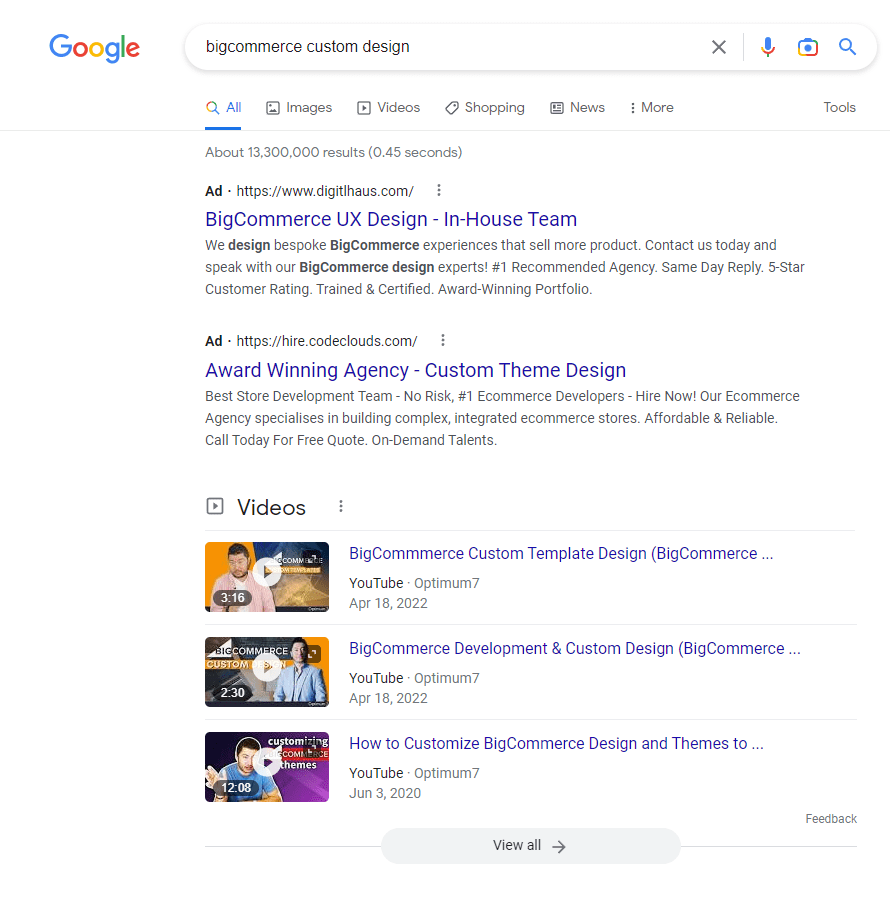
This is a very important keyword for us.
This is a really high-volume keyword for anybody, and any lead that comes from this keyword is worth $20,000 to $50,000. And a couple of hours of Youtube SEO was all it took us to rank number one on the videos, on the search results pages for this term.
Now we’ve done this over and over and over again. For almost every single possible e-commerce migration that you can think of between any two platforms, 95% of them were ranked on the first page.
You don’t even have to click on the “Videos” section. As long as you scroll past the ads, once the video results are triggered, we are usually number one or number two. You’ll definitely see us on the first page no matter what.
This is EXTREMELY important for B2B businesses and B2B service-based businesses.
Another thing is, if there’s no video on that keyword, we don’t know if Google’s going to trigger that source result or not. But we have made it trigger video results. How did we do that?
By optimizing the videos.
Because people forget Google owns YouTube. And Google loves Google. Google loves to keep people, customers, and users on their own properties. So of course they’re going to showcase YouTube on their search results.
So if they see a piece of video content that is well optimized, that provides them with all the information, your video will trigger video results. As long as you provide them with subtitles, tags, an optimized video title, an optimized description, hashtags in the video, and timeframes in the video, you can make Google trigger video results, just by optimizing a video properly.
The Business Side of Why Google Loves YouTube
Let’s explain the business side of why Google loves Youtube. Do you think that Google’s user base is increasing?
No. 97% of users out there already use Google. So as a for-profit organization, how can Google make more money and how can they create more profit?
They can channel search results traffic to other properties where they can generate more ad revenue.
Why Do You Think Google Bought YouTube?
Why do you think that Google displays YouTube results on search results and tries to pull users into YouTube? Because 90% of the ad revenue that Google generates is still from keyword searches, Google shopping, and smart shopping campaign results.
Google is working on maximizing YouTube ad revenue. That is why they’re going to show those YouTube videos more and more on search results, because they want to channel those users into YouTube.
And we all know once you go on YouTube, you’re never leaving. And the more you watch, the more likely you are to click on an ad. This is a very basic formula if you understand how online marketing works and if you follow the P&L statements for Google.
How to Start Doing Youtube SEO
Let’s say you’re a business owner. You know nothing about shooting a video, let alone optimizing it, you don’t have a video guy, and you don’t have a video creation process.
How Do You Get Started?
Well, if you know nothing, you need to find somebody that knows something. For example, we work with a lot of clients, like let’s take Arlyn Scales for example. They sell industrial scales, one of the most boring products that you could possibly imagine.
And of course, they know nothing about video. They’re one of our oldest clients that’s been with us for a while. We approached them with a strategy and they were like, “All right, let’s do it. Why not?” They know nothing, so they just put it in our hands. What we did was work with one of our SEO specialists to find keywords that were just slightly triggering videos on Google search results.
Because industrial skills is not something that is popping off on YouTube, or even that YouTube has a lot of content on. It’s not something sexy.
Yet the clicks are worth it.
Also, even though it might not be appealing or it might not be creative, it is still pretty competitive on Google search results. So if you can just get one piece of content on YouTube that is well optimized and it can break through into the first page, boom, you’re already one step ahead of your competitors.
Let’s not ignore the fact that most industrial businesses are not doing videos. So if you are the first brand in your field to start doing this type of creative strategy, you’re 10 steps ahead of your competition, and this is what this strategy is all about.
There’s a specific optimization process for this.
The last part of this is where we kind of cheat the system. We get artificial views through YouTube ads.
It’s slightly cheating the system, even though it’s really not because both Google and YouTube know you’re doing it. Google’s much more likely to push videos on search results that are getting views.
Even if it’s just through ads, it has been approved by Google, it is clearly content that is relevant, good, approved by Google. So even if it’s just getting views through paid search, which is just on YouTube, not on Google, we’re getting views, Google likes it, and they push the traffic more easily.
Remember the example we gave at the start of this article?
Type BigCommerce Custom Design onto Google, search results are going to pop up with our video. You’ll see the timeline. If you click on that video and go to YouTube, look at how many views that video has.
Do you think that that video got those views organically? No.
We created an ad on Google AdWords and put around $10 or $20 behind it to attract tens of thousands of views. That’s when Google started ranking us number one for that video.
5 Fundamental Youtube SEO Tips that You Should Start Doing Right Now
Here are 5 really basic and easy-to-do Youtube SEO practices that you can do (and should start doing) as soon as possible.
1. Tag your video with popular keywords that relate to your topic.
YouTube tags are key for optimizing your videos and helping more viewers find them. Not only do they inform viewers about the video but also allow YouTube to understand the context and content of your video in order to associate it with similar videos that could help broaden your reach.
When creating YouTube tags, choose wisely; choose relevant tags rather than those that you think could possibly get you more views because Google may penalize you for doing so, or worse, recommend fewer views of your video. Also, lead with common keywords and long-tail keywords, like “how do I” questions that answer a specific topic, so that viewers can easily find exactly what they are looking for.
2. Optimize your video description.
When it comes to YouTube SEO, it’s always important to start with the basics. That includes ensuring your YouTube video descriptions are within the official character limit of 1,000 characters.
While it is okay to opt for a longer description, be aware that YouTube only displays the first two or three lines in-app before the viewer has to click “show more” to see the full description. As such, it’s a good idea to front-load the description with your most important information like CTAs and essential links.
Additionally, you may choose to add a transcript for those who have to watch without sound; research from Backlinko suggests this can have a positive effect on SEO. No matter what approach you take for YouTube SEO, staying informed about 2021 guidelines is key to success.
3. Rename your video file with your target keyword.
To optimize your video content, start by using an SEO tool to determine the target keyword you want to focus on. Many popular YouTube SEO tools are available for you to browse through (you can find links to them below).
Once you have identified your keyword, it is crucial to include it in the video file name before uploading it to YouTube. This is because YouTube cannot actually “watch” your video to determine its relevance to the target keyword.
Furthermore, as the tips below will demonstrate, there are only a limited number of safe places to insert the keyword on the video’s viewing page after it has been published. However, YouTube can read the file name and accompanying code when the video is uploaded.
4. Add an SRT file to your upload for subtitles and closed captions.
Adding subtitles and closed captions to your videos is an essential part of YouTube optimization. This can be done by uploading a supported text file, such as an SRT File. Not only will these help viewers better understand what you’re saying in the video, but they’ll also boost its searchability when it comes to containing important keywords.
Adding subtitles or closed captioning to your videos is simple, just head to your video manager and click “Videos” under Video Manager. Then, pick the video you want to work on from the list, press the drop-down arrow next to its edit button, and select Subtitles/CC.
5. All of your videos should have a custom thumbnail
Creating custom thumbnails for your YouTube videos is a great way to boost engagement and capture the attention of viewers. These visuals, which appear alongside your titles, increase the likelihood that people will pause on your video and then click through to watch it.
Designing compelling thumbnails can be made easier with various online tools. Some allow you to easily insert text, images, and other design elements, while others offer pre-made templates or stock photos that you can use.
Spending a few moments designing an eye-catching thumbnail could greatly help increase the views of your videos.
YouTube SEO is a Must for All Businesses in 2023
In conclusion, video SEO is a powerful process that can help businesses rank on the first page of Google search results. By optimizing video content you can tap into the untapped potential of video SEO.
Google’s increasing use of video results for certain search terms, coupled with its ownership of YouTube, makes it more important than ever to optimize video content. Additionally, optimizing video content can help you to maximize ad revenue, as Google channels users to YouTube.
If you’re new to video marketing, it’s important to find someone with expertise in the field who can help you create and optimize effective video content. To collaborate with YouTube SEO and video marketing experts, reach out to our team today.

